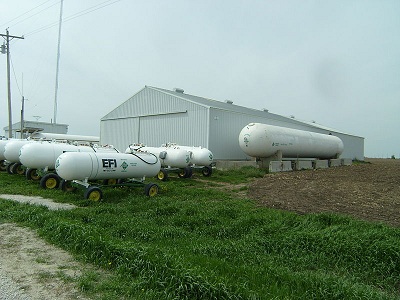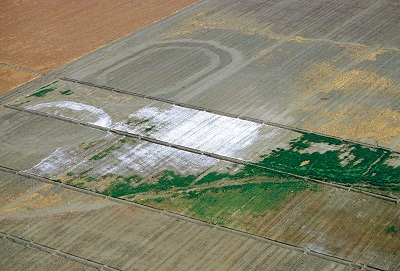Human and Soil Interactions
Since soil is so vital to human life, humans have to move and manipulate it in order to utilize it. This, however, can lead to environmental problems, soil loss, and degradation. Soil degradation is a human-induced or natural process which impairs the capacity of soil to function. As an example, in 3000 BC, the Sumerians built large cities in the deserts of Southern Mesopotamia. Using irrigation, they farmed the desert soils and created large food surpluses that made their civilization possible. But around 2200 BC, the civilization collapsed. Scientists debate why, but one reason may be tied to the soil. Irrigating in dry climates can cause a buildup of salt, a process called salinization. Few crops can tolerate salt. The soil in this region still remains too salty to grow crops. Other activities that degrade the soil include contamination, desertification, and erosion.
The bottom of the page has links to soil erosion and desertification fact sheets for download and printing.
Erosion

Erosion occurs when soil particles are detached, transported, and depositied. Erosion is a natural geologic process, examples of geologic erosion can be found in this animation by McDougal and Little; however, humans can accelerate the process by removing cover. Accelerated erosion occurs at 10-1000 times the natural rate. Erosion can happen in all of the biomes on earth, and can be caused by removing trees or grasses. Removing the soils generally leads to other types of degradation and reduced food production. Soil can be eroded by wind or water. For more information about erosion, visit the erosion page.
Desertification
 Increasing droughts can eventually turn an area into a desert. This is a dry riverbed in California. Credit: US National Oceanic and Atmospheric Administration. 2009
Increasing droughts can eventually turn an area into a desert. This is a dry riverbed in California. Credit: US National Oceanic and Atmospheric Administration. 2009
Desertification is the extreme degradation of productive land in arid and semi-arid areas. This is most common in the tropical savannah and prairies. This can create poor quality vegetation, and the spreading of deserts to areas that weren't deserts before. More information can be found at the desertification page.
Acidification

An Anhydrous Ammonia Fertilizer distribution center in France. Credit: Wikimedia Commons.
Acidification occurs when the basic cations (like Calcium and Magnesium) leach from the soil, leaving the acidic cations in the soil (Hydrogen, Aluminum, iron and manganese). The pH decreases and soil becomes more acidic. This is a natural process in weathering. However, the use of certain fertilizers to provide food, like anhydrous ammonia, causes soil to become more acidic much faster. This can occur in all biomes.
Deforestation

Land cleared for a type of shifting cultivation practiced in North-east India. This photo from Gandhigram in Vijaynagar circle of Arunachal Pradesh, India. 2006.
Deforestation is a very severe problem. More information can be found at the deforestation page.
Salinization

This build up of salt on the soil surface is called salinization. This is a very big problem in the desert and prairie biomes. This can cause physical soil damage, and the ability to grow plants. For more about it, visit the salinization page.
Mining
 Strip Mined Eroded Land Erodes, especially if not recontoured by the coal companies near New Athens Ohio (1974). Credit: US National Archives 412-DA-13143.
Strip Mined Eroded Land Erodes, especially if not recontoured by the coal companies near New Athens Ohio (1974). Credit: US National Archives 412-DA-13143.
Surface mining can drastically change the landscape. When the materials are gone, soil science becomes very important to the reclamation process, which aims to restore the landscape and plants to pre-mining conditions.
Urbanization

The urbanization page details the process.
A summary of how construction changes the landscape can be found on the Engineering and Urban Interactions page.
Go back to Soil and People page



